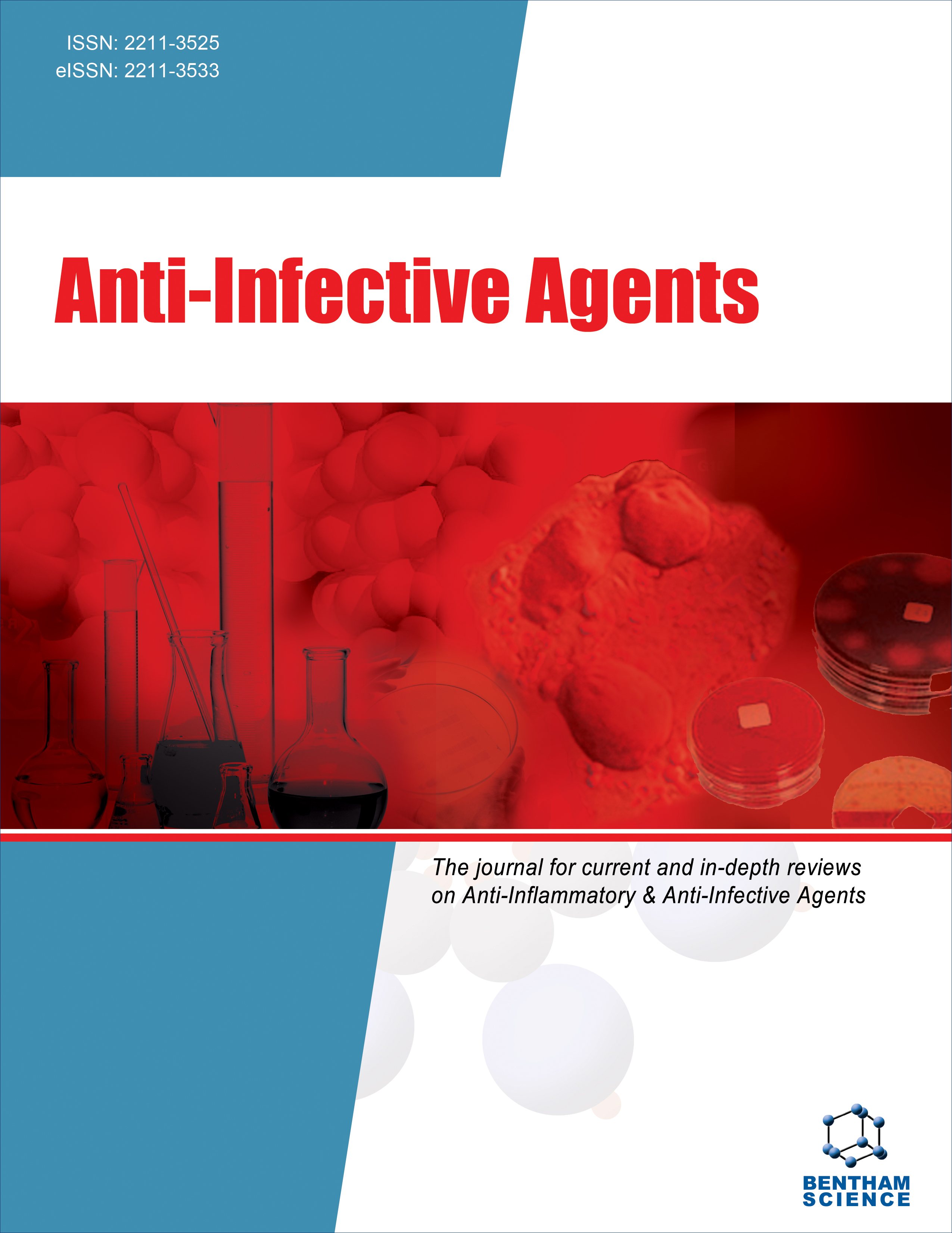- Home
- A-Z Publications
- Anti-Infective Agents
- Previous Issues
- Volume 12, Issue 1, 2014
Anti-Infective Agents - Volume 12, Issue 1, 2014
Volume 12, Issue 1, 2014
-
-
Unsaturation: An Important Structural Feature to Nucleosides’ Antiviral Activity
More LessIn the search of effective, selective and nontoxic antiviral agents, a variety of nucleoside analogues have been synthesized, with different functionalities in the carbohydrate moiety and/or the heterocyclic base. Nucleoside analogues bearing double or triple bonds are recognized as an important class of biologically active compounds and appear to be prominent drugs in the management of several viral infections, inclu Read More
-
-
-
Population Pharmacokinetics and Pharmacodynamics of Albinterferon Alfa-2b in Patients Treated for Hepatitis C Virus Genotype 2/3
More LessAuthors: Jing Yu, Haiying Sun, Maria Pang, Wan-Long Chuang, Shiv K. Sarin, Robert Flisiak and Daniel S. SteinAlbinterferon alfa-2b (albIFN) has been studied for the treatment of chronic hepatitis C virus infection in combination with ribavirin at different dose regimens ranging 900-1500 µg once every 2 (q2w) or 4 (q4w) weeks. Analyses on efficacy and safety exposure-response relationships in Genotype2/3 (G2/3) interferon-naïve patients were conducted to explore an improved risk-benefit of therapy. Data from 972 G2/3 patien Read More
-
-
-
Characterization of a Bacteriocin of Pediococcus pentosaceus SB83 and Its Potential for Vaginal Application
More LessAuthors: Sandra Borges, Joana Barbosa, Joana Silva and Paula TeixeiraListeria monocytogenes, the responsible agent for listeriosis, is one of several microorganisms which can be transmitted from mother to fetus/neonate by vertical transmission. The aim of this study was to characterize a bacteriocin produced by Pediococcus pentosaceus SB83 for vaginal application, to prevent colonization of pregnant women with L. monocytogenes. Bacteriocin SB83 showed inhibitory activity agai Read More
-
-
-
Non-Genotoxic Assessment of a Natural Antimicrobial Agent: Squalamine
More LessAuthors: Kamel Alhanout, Carole D. Giorgio, Michel D. Meo and Jean M. BrunelSqualamine, a natural aminosterol compound isolated from the dogfish shark Squalus acanthias, is reported to possess high antimicrobial activities. Herein, we assessed its in vitro genotoxic properties by using the Ames test and the micronucleus assay. All the experimental results demonstrate that squalamine is a non genotoxic molecule and call for further work to evaluate its potent human therapeutic use as a new class of an Read More
-
-
-
Bacterial Fatty Acid Synthesis: Effect of Tween 80 on Antibiotic Potency Against Streptococcus Agalactiae and Methicillin-Resistant Staphylococcus Aureus
More LessAuthors: Dragan Krsta, Caron Ku, Ian T. Crosby, Ben Capuano and David T. ManallackThe effect of varying concentrations of Tween 80 on the antimicrobial potency of platensimycin and triclosan was investigated using both Streptococcus agalactiae (S. agalactiae) and methicillin-resistant Staphylococcus aureus (MRSA). In the presence of very low concentrations of Tween 80 (0.02%) both platensimycin and triclosan were rendered ineffective against S. agalactiae. A linear concentration-dependence Read More
-
-
-
Synthesis and Evaluation of N-Substituted Thiazolidine-2,4-dione Containing Pyrazole as a Potent Antimicrobial Agents
More LessIn search of new antimicrobial agents with improved potency, we have synthesized a series of N-substituted thiazolidinedione-pyrazole based 3-(3-(1H-pyrrol-1-yl)propyl)-5-((3-(substituted phenyl)-1-phenyl-1H-pyrazol-4-yl) methylene)thiazolidine-2,4-diones (6a-j) in two successive steps. Initial step involves Knoevenagel type condensation of 3-(substituted phenyl)-1-phenyl-1H-pyrazole-4-carbaldehydes (2a-j) with thiazolidine-2,4 Read More
-
-
-
Mini-Review: Polyamines Metabolism, Toxicity and Potent Therapeutical Use
More LessAuthors: Lamia Djouhri-Bouktab, Jean M. Rolain and Jean M. BrunelIn recent years, extensive researches have emphasized the fact that polyamines conjugates acting as possessing antitumor, antimicrobial candidates are becoming important in the biogical and medicinal field. In this review, a general design strategy of polyamine conjugates as well as recent progress in both fundamental mechanism studies and potent therapeutic use as anti infectious agents are provided for the readers.
-
-
-
An Efficient Synthesis and Antiviral Activity Evaluation of 1-[4-(5-Phenyl- 4, 5 dihydro-1H-pyrazole [& (4, 5 dihydroisoxazole)]-3-yl)-phenyl]-pyrrole- 2, 5-dione Derivates
More LessAuthors: Jigarkumar Patel, Mahesh Malani, Graciela Andrei, Jan Balzarini, Robert Snoeck and Bharat DholakiyaPreparation of new series of 1-[4-(5-Phenyl-4,5 dihydro-1H-pyrazole-3-yl)-phenyl]-pyrrole-2,5-dione and 1-[4- (5-Phenyl-4,5 dihydroisooxazole-3-yl)-phenyl]-pyrrole-2,5-dione derivatives, derived from α,β-unsaturated ketones with objective of obtaining lead compounds for future development as antiviral agents. The inhibition of virus-induced cytopathicity or plaque formation in HEL [herpes simplex virus type 1 (HSV-1) (KOS), HSV- Read More
-
-
-
Effect of Electronegative Groups on the Antimicrobial Activity of 3, 5- Disubstituted Thiazolidine-2,4-diones
More LessAuthors: Radhe S. Bahare and Swastika GangulyA series of 30 novel thiazolidine-2,4-diones (3a-o, 4a-o) have been synthesized and evaluated for their antibacterial and antifungal activities against pathogenic microorganisms Gram-positive bacteria: Staphylococcus aureus, Bacillus subtilis, Gram-negative bacteria: Escherichia coli, Pseudomonas aeruginosa, Salmonella typhi, Klebsiella pneumonia, and fungal strains Candida albicans, Aspergillus niger using two fold s Read More
-
-
-
Non-Microbicidal Control of Bacterial Biofilms with Small Molecules
More LessAuthors: Roberta J. Worthington, Justin J. Richards and Christian MelanderBacterial biofilms are defined as a surface attached community of bacteria embedded in a matrix of extracellular polymeric substances that they have produced. When in the biofilm state, bacteria are more resistant to antibiotics and the host immune response than are their planktonic counterparts. Biofilms are increasingly recognized as being significant in human diseases such as; lung infections of cystic fibrosis (CF), c Read More
-
Most Read This Month
Article
content/journals/aia
Journal
10
5
false
en


